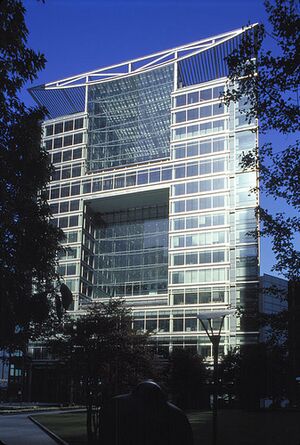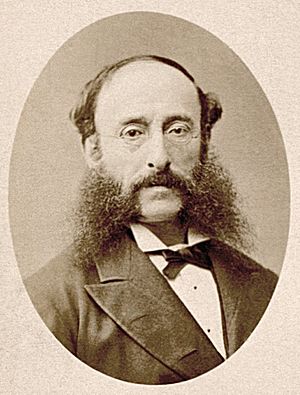Reuters facts for kids
 |
|

Reuters' headquarters at 5 Canada Square in Canary Wharf, London
|
|
| Division | |
| Industry | News agency |
| Founded | October 1851 |
| Founder | Paul Julius Reuter |
| Headquarters | 5 Canada Square, Canary Wharf, London, England |
|
Area served
|
Worldwide |
|
Key people
|
|
| Owner | Thomson family |
|
Number of employees
|
25,000 |
Reuters is a major news agency that belongs to Thomson Reuters. It has about 2,500 journalists and 600 photojournalists working in around 200 places worldwide. They write news in 16 different languages. Reuters is known as one of the biggest news agencies in the world.
The agency started in London in 1851, founded by Paul Reuter. In 2008, a company from Canada called Thomson Corporation bought Reuters. This led to the creation of the Thomson Reuters Corporation.
In December 2024, Reuters was ranked as the 27th most visited news website globally. It had more than 105 million readers each month.
Contents
History of Reuters News
How Reuters Began

Paul Julius Reuter used to work at a book company in Berlin. He was involved in sharing important papers during the Revolutions of 1848. In 1850, Reuter created an early news service in Aachen. He used homing pigeons and electric telegraphy to send messages. This helped him send news between Brussels and Aachen starting in 1851.
In 1851, Reuter moved to London and set up his news wire agency. It was located at the London Royal Exchange. His company first focused on business news for banks and other companies. The first newspaper to use Reuters' news was the London Morning Advertiser in 1858.
Reuters became very important because it could report big international stories quickly. For example, it was the first to report Abraham Lincoln's assassination in Europe in 1865. In 1865, Reuter made his business an official company called Reuter's Telegram Company Limited. He became its managing director.
Growing Around the World
Around 1870, three big news agencies, French Havas, British Reuter's, and German Wolff, made an agreement. This agreement, called the Ring Combination, gave each agency its own areas to cover news. Reuters was very strong in this group because its areas were large and important. It also had more staff around the world. This meant Reuters provided a lot of original news. London was also a key place for world news because Britain controlled many cable lines.
In 1872, Reuter's expanded its news coverage to the Far East. Then, in 1874, it expanded to South America. These expansions were possible because of new ways to send messages over land and under the sea. In 1878, Reuter retired, and his oldest son, Herbert de Reuter, took over. By 1883, Reuters was sending news to London newspapers using electricity.
Reuters in the 20th Century
Herbert de Reuter continued to manage the company until he passed away in 1915. In 1916, the company became private again. Roderick Jones and Mark Napier bought all the shares. They changed the company's name to "Reuters Limited." In 1923, Reuters started using radio to send news internationally, which was a new idea at the time. In 1925, the Press Association (PA) in Great Britain bought most of Reuters. Later, they owned the whole company.
During the world wars, Reuters faced pressure from the British government. The government wanted Reuters to serve national interests. In 1941, Reuters changed its structure to stay independent. The PA sold half of Reuters to the Newspaper Proprietors' Association. By 1947, newspaper groups in New Zealand and Australia also became co-owners. These new owners created the Reuters Trust. The Reuters Trust Principles were put in place to make sure the company stayed independent. At this point, Reuters was a major news agency. It provided news and pictures to newspapers, other news agencies, and TV and radio stations.
In 1961, Reuters was the first to report on the building of the Berlin Wall. In the 1960s, Reuters was also one of the first news agencies to send financial information across oceans using computers. In 1973, Reuters started showing foreign exchange rates on computer screens for its clients. In 1981, Reuters began to support electronic trading on its computer network. It then created many electronic services for buying and selling. Reuters became a public company in 1984. Its shares were listed on stock exchanges like the London Stock Exchange (LSE) and NASDAQ. Reuters also published the first story about the Berlin Wall being opened in 1989.
In the 1990s, Reuters was a leading news service on the Internet. It achieved this by working with early internet news providers like ClariNet and PointCast.
Reuters in the 21st Century
Reuters' share price went up during the dotcom boom. Then it dropped after banking problems in 2001. By 2002, most news around the world came from three main agencies: the Associated Press, Reuters, and Agence France-Presse.
Until 2008, the Reuters news agency was part of an independent company called Reuters Group plc. In 2008, Thomson Corporation in Canada bought Reuters. This created Thomson Reuters. In 2009, Thomson Reuters stopped listing its shares on the LSE and NASDAQ. Instead, it listed them on the Toronto Stock Exchange (TSX) and the New York Stock Exchange (NYSE). The last living member of the Reuters founding family, Marguerite, Baroness de Reuter, passed away in 2009. The main company, Thomson Reuters, is based in Toronto. It provides financial information to clients and continues its traditional news business.
In 2012, Jim Smith became the CEO of Thomson Reuters. In July 2016, Thomson Reuters sold its intellectual property and science part of the business. In October 2016, Thomson Reuters announced plans to expand and move some operations to Toronto. As part of changes, in November 2016, Thomson Reuters Corp. reduced about 2,000 jobs. On March 15, 2020, Steve Hasker became the president and CEO.
In April 2021, Reuters announced that its website would require a payment to access content. This was similar to what other news organizations had done. In March 2024, Gannett, a large newspaper publisher in the United States, signed a deal with Reuters. This allowed Gannett to use Reuters' global news content.
In 2024, Reuters staff won the Pulitzer Prize for National Reporting. They won for their work on Elon Musk and problems at his businesses. These included SpaceX, Tesla, and Neuralink. They also won the Pulitzer Prize for Breaking News Photography for their pictures of the Gaza war.
Reuters Journalists
Reuters has about 2,500 journalists and 600 photojournalists working in around 200 places worldwide. Reuters journalists follow "Standards and Values." These guides help them report news fairly and accurately. They aim to keep Reuters' reputation for being reliable, accurate, fast, and exclusive.
Journalists sometimes face dangers while reporting. In May 2000, Kurt Schork, an American reporter, was killed in an ambush in Sierra Leone. In April and August 2003, news cameramen Taras Protsyuk and Mazen Dana were killed in separate events in Iraq. In July 2007, Namir Noor-Eldeen and Saeed Chmagh were killed in Baghdad. In 2004, cameramen Adlan Khasanov and Dhia Najim were also killed. In April 2008, cameraman Fadel Shana was killed in the Gaza Strip.
While covering China's Cultural Revolution in the 1960s, Reuters journalist Anthony Grey was held by the Chinese government. This happened because some Chinese journalists were jailed in Hong Kong. He was held for 27 months, from 1967 to 1969. After his release, he received an award from the British Government. He later became a successful writer of historical novels.
In May 2016, a Ukrainian website published the names and personal details of many journalists. This included Reuters reporters. These journalists had been approved by authorities in eastern Ukraine.
In 2018, two Reuters journalists were found guilty in Myanmar. They were accused of getting state secrets while looking into a difficult situation in a Rohingya village. Many people said their arrest and conviction were an attack on press freedom. The journalists, Wa Lone and Kyaw Soe Oo, received several awards. They were also named among the Time Person of the Year in 2018. After 511 days in prison, Wa Lone and Kyaw Soe Oo were set free on May 7, 2019.
In February 2023, a team of Reuters journalists won the Selden Ring Award. They won for their investigation into human rights issues by the Nigerian military.
Journalists Killed While Reporting
| Name | Nationality | Location | Date | Responsible party |
|---|---|---|---|---|
| Kenneth Stonehouse | British | Bay of Biscay | 1 June 1943 | German Aircraft |
| Hos Maina | Kenyan | Somalia | 12 July 1993 | |
| Dan Eldon | Kenyan | Somalia | 12 July 1993 | |
| Kurt Schork | American | Sierra Leone | 24 May 2000 | |
| Taras Protsyuk | Ukrainian | Iraq | 8 April 2003 | U.S. troops |
| Mazen Dana | Palestinian | Iraq | 17 August 2003 | U.S. troops |
| Adlan Khasanov | Russian | Chechnya | 9 May 2004 | Chechen Separatists |
| Waleed Khaled | Iraqi | Iraq | 28 August 2005 | U.S. troops |
| Namir Noor-Eldeen | Iraqi | Iraq | 12 July 2007 | U.S. military Apache helicopter |
| Saeed Chmagh | Iraqi | Iraq | 12 July 2007 | U.S. military Apache helicopter |
| Fadel Shana'a | Palestinian | Gaza Strip | 16 April 2008 | Israeli Troops |
| Hiro Muramoto | Japanese | Thailand | 10 April 2010 | Thai Troops |
| Molhem Barakat | Syrian | Syria | 20 December 2013 | Syrian Forces/Rebels |
| Danish Siddiqui | Indian | Afghanistan | 16 July 2021 | Taliban |
| Issam Abdallah | Lebanese | Lebanon | 13 October 2023 | Israeli Troops |
See also
 In Spanish: Reuters para niños
In Spanish: Reuters para niños
- Electronic Broking Services, a company that competes with Reuters
- List of news agencies
- Media of the United Kingdom
Things Related to Reuters
- Reuters Instrument Code
- Reuters Insider
- Reuters Market Data System
- Reuters Market Light
- Reuters 3000 Xtra
- Reuters TV
Things Related to Thomson Reuters
- Thomson Reuters Business Classification
- Thomson Reuters Citation Laureates
- Thomson Reuters Foundation
- Thomson Reuters Indices
- Thomson Reuters/Jefferies CRB Index
- Thomson Reuters league tables
- Thomson Reuters Messenger
- Thomson Reuters Realized Volatility Index


